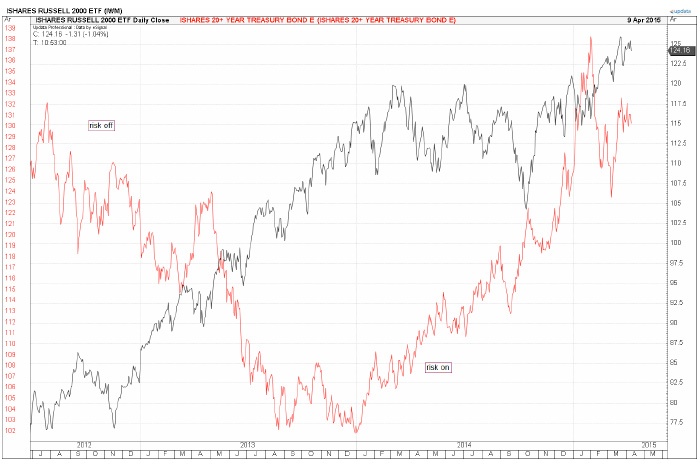
A risk-off trade occurs when the investors or market players become scared or frightened about financial events or global happenings. Their tolerance for pain from a loss becomes limited and the asset of choice becomes something safe like a Treasury bill or note, triple AAA bonds, other vehicles that are perceived as safe, and (of course) cash.
The employment of this type of investment removes risk of loss from the investments and at the same time gives up growth and yield. This behavior is generally seen during times of crisis such as the Greek debt problems, the 2008-2009 financial crisis, European Central Bank issues, currency problems in Russia, and so on, or in other risks to the economy or global arena. Typically, during a recession, or perceived recession, the risk-off trade prevails and we see money put to work in safe government bonds or insured bonds. Is there growth in these portfolios? Not much, but the minuscule return is more pleasant than the chance that a loss will occur. The iShares 20+ Year Treasury Bond ETF (TLT) is an example of a risk-off vehicle. SPDR Barclays High Yield Bonds ETF (JNK) is the opposite.

Source: UDATA
Notice on the chart that the black line, that of TLT, seems to go in the opposite direction as that seen for the red JNK chart. TLT is a risk-off trade, and JNK is a risk-on trade. What are the differences? Risk and yield. Also notice that when these lines cross, the red going down and the black going up, the chart is telling you that complacency and good feelings are not abundant in the markets. You do not need a newsfeed to observe this change in mood.
In recent days, we have seen the risk-on trade return. We have seen the iShares Russell 2000 ETF (IWM) approach an all-time high. This ETF is the poster child for U.S. growth companies. If the market perceives stability and no threats to our economy, this ETF becomes the vehicle of choice for many investors. Additionally, this ETF is less adversely affected by the strong U.S. dollar, as most of the companies in this index are not as reliant on exports as larger companies. The emerging markets ETF, EEM, similarly seems to be a magnet for risk-on trades.
The market is in an interesting position now, hanging on the words of Fed Chair Janet Yellen and other members of the FOMC. While markets have recently reacted positively to the statements that the Fed will move slowly on interest hikes, the consensus is they should begin to appear sometime in late 2015.
What happens when interest rates go higher? The US. dollar should rally further and U.S. multinational companies will face further challenges in exporting their products. How will that impact the S&P 500? Will it be a negative for the markets as earnings are impacted by the strong currency? Frankly, the FOMC is in a very difficult position. In my opinion, if they keep interest rates at almost zero, they risk inflation. We are probably at greater risk currently of deflation. A strong U.S. dollar is deflationary, not inflationary.
The lesson to be learned is that no one asset class or sector trades without reflecting the influence of macroeconomic events and monetary policies around the globe. Markets are more interconnected than ever before, and analysis must be employed that looks at the bigger picture. Take a look at the seemingly contradictory influences in our markets these days. We have higher interest rates than most of Europe. Therefore, money moves into our markets from abroad, which in turn supports our markets and a risk-on trade … until it doesn’t.
The opinions expressed in this article are those of the author and do not necessarily represent the views of Proactive Advisor Magazine. These opinions are presented for educational purposes only.
 Jeanette Schwarz Young, CFP, CMT, CFTe, is the author of the Option Queen Letter, a weekly newsletter issued and published every Sunday, and "The Options Doctor," published by John Wiley & Son in 2007. She was the first director of the CMT program for the CMT Association (formerly Market Technicians Association) and is currently a board member and the vice president of the Americas for the International Federation of Technical Analysts (IFTA). www.optnqueen.com
Jeanette Schwarz Young, CFP, CMT, CFTe, is the author of the Option Queen Letter, a weekly newsletter issued and published every Sunday, and "The Options Doctor," published by John Wiley & Son in 2007. She was the first director of the CMT program for the CMT Association (formerly Market Technicians Association) and is currently a board member and the vice president of the Americas for the International Federation of Technical Analysts (IFTA). www.optnqueen.com
Recent Posts:
